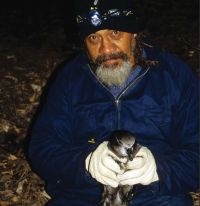Tēnā koutou Tēnā koutou

Welcome to this edition of Discovery, which we have devoted to kōrero from our work with iwi and Māori organisations.
Since the formation of Manaaki Whenua as a Crown Research Institute (CRI) 20 years ago we have valued highly our collaborations and friendships in the Māori community. Many of the stories of recent projects in this edition have long histories. I especially acknowledge the work of Manaaki Whenua leaders Dr Andrew Pearce and Dr Oliver Sutherland who, guided by Rau Kirikiri through the 1990s, gave momentum to those relationships at the heart of this organisation. Now, in 2012, I am delighted to welcome back Rau to our Senior Leadership Team, albeit in a part-time role fitting in with his other responsibilities, in the role of Māori kaihautū (steersman/guide). Rau has written his own welcome on the next page.
Māori industry and organisations are increasingly dealing with complex multi-dimensional environmental issues that threaten Māori relationships with the natural environment (e.g. water pollution, water allocation, climate change, biodiversity, competition for land resources). These issues impact on the social and cultural well-being and economic prosperity of Māori. Strong drivers for Māori are to manage their resources sustainably and to protect cultural assets for future generations while at the same time achieving economic prosperity, especially following Treaty settlements.
Vision Mātauranga has emerged increasingly within policy frameworks since 2007 and was incorporated into the CRI’s Statements of Core Purpose (SCP) during late 2010. CRIs are now required, as part of their operating principles, to enable the innovation potential of Māori knowledge, resources and people for the benefit of all New Zealanders.
Manaaki Whenua is committed to sustaining responsive relationships with iwi and Māori organisations that enable collaborative projects and investment to develop new knowledge, services and innovative environmental solutions that support sustainable economic development.
Māori are intergenerational guardians of significant natural resources and indigenous knowledge as well as being owners and managers of commercial assets. As such, Māori are important partners in science and innovation and increasingly appreciate the role that science can play in economic development. Manaaki Whenua is committed to exploring the interface between traditional knowledge, Māori world views and science. We seek to develop those links in a way that increases society’s appreciation of Māori relationships between the natural world, the economy and people.
Māori perspectives, practices, values and knowledge, obtained from systematic and intergenerational observation and experience, can contribute to our knowledge of biodiversity, land resources and ecosystems. The concept of kaitiakitanga offers a distinctive approach to understanding and managing New Zealand’s natural resources. As such, there are opportunities for Māori–CRI partnerships for mutual advantage, as demonstrated in our relationships with Tūhoe, Ngāti Awa, Ngāti Wai and Ngā Uri o Whakakii.
Manaaki Whenua is also committed to building the bicultural capability of our staff, particularly those that come from overseas, to ensure that they understand the cultural context, dynamics, and environment when engaging and working with Māori communities in their fieldwork. Over the past four years, we have undertaken Te Reo and waiata sessions with staff at our Lincoln, Auckland, Hamilton and Palmerston North sites. Recently, we have reintroduced tikanga sessions and Treaty of Waitangi appreciation courses.
Manaaki Whenua is also committed to building our Māori research capability. Over the past four years we have employed a number of strategies, including recruiting new Māori scientists/researchers, integrating more of our non-Māori staff with an active interest in Māori research into more of our Māori research projects, partnering with Māori research institutions, and working collaboratively with iwi/hapū-based researchers. The challenges include the low participation rates of Māori in science, very low Māori capacity, and current low Māori educational attainment rates in science, engineering and technology. Finding Māori talent is one challenge, but keeping them in a CRI environment when their skills are needed so much in the Māori community is the next challenge, and it requires new strategies and innovative thinking. But we embrace the challenge and continue to seek to grow our Māori staff in science.
I hope you enjoy the stories in this edition of Discovery and appreciate the wealth of opportunities that emerge from them.
Dr Richard Gordon
Chief Executive
Message from Rau Kirikiri, Māori Kaihautū, Manaaki Whenua
E ngā karangatanga maha puta noa, tēnei te tangi a te mōkai kua hoki mai ki tōna ūkaipō. Inā i wehe atu kia tirohia te ao, ā, kua tatū mai anō hei pou ārahi mo te hunga nei. I puta mai te karanga kia hau mai anō ki te manaaki i a rātou e whakapau kaha ana ki te whakapakari i te iwi Māori. Kua huri anō te kei o tēnei waka ki te tautoko i ngā hiahia, i ngā moemoea o tāua te Māori. Na, ko te aronui kia haere ngātahi a Manaaki Whenua me ngā iwi katoa o te motu i runga i te huarahi kotahi, i runga i te huarahi tika mo te katoa.
It is a pleasure for me, yet again, to be a part of the exciting research that Manaaki Whenua undertakes, albeit on a part-time basis only. The last five or so years as an independent consultant have opened my eyes to even more opportunities for Māori in the field of science research that hitherto were not so obvious. Treaty claims settlements, amongst others, have increased the ability of iwi to pursue long-term development options with vigour. I am encouraged that Manaaki Whenua will be a dedicated partner in that effort, as it always has been.
